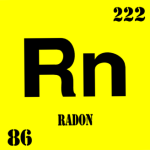
What is Radon?
We often hear about Carbon Monoxide as the silent killer in our homes, but what if I told you there is another little known gas that could be seeping in your home that kills 27 times more people on average and causes 1,100 deaths per year? Yes it’s true and this dangerous gas is called Radon.
Radon is a radioactive, colourless, odourless gas that is naturally present throughout most homes. the gas is emitted in varying quantities. It comes from Uranium, which is naturally present in rocks and soils. Studies show that Radon in higher concentrations can be a leading cause of lung cancer.
As Radon is emitted from the ground, it quickly moves into the atmosphere into relatively harmless concentrations. But in confined unventilated spaces in buildings, basement and underground areas , the concentration levels can become dangerously high.
More thorough research was conducted in the UK during the 1970’s and 1980’s which recognized the concentrations of Radon in residential dwellings and buildings that indicated concentrations reached a significantly high level which would present a risk of lung cancer.
Following this research, the UK government introduced a series of policies and regulations for the monitoring, recording and reporting of Radon levels, as well as some form of guidance in terms of the mitigation of Radon levels in building. In 1991, building regulations first introduced a requirements that Radon protection measures be incorporated within the design of mew buildings.
Radon itself does not really cause sever tissue damage. Radon gas can be inhaled and exhaled with little damaging effect, however the precipitation of isotopes within the lung tissue, and their degradation can have a serious carcinogenic effect.
Based on current research, it is estimates that 1,100 lung cancer deaths per annum are a direct result of exposure to high concentrations of Radon. This is much higher that the reported number of deaths of people with lung cancer associated with asbestos.
Radon levels are measured in Becquerels per cubic metre (Bq/m3). In the UK, the action level is 200 Bq/m3. . Which would represent the recommended limit for the activity concentration of Radon is UK homes. With Radon levels that high, the lifetime risk of a non-smoker developing lung cancer is less than 1 in 200, but increases to 1 in 7 for a current smoker.
Concentration levels of Radon within buildings can vary quite a but and are influence by a number of factors, such as location. Some parts of the UK will have higher that normal levels due to the nature of the underlying bedrock. Buildings that have a higher level of natural or mechanical ventilation tend to have lower concentrations of Radon, for example where the ground floors have a ventilated cold below them.
Public Health provides information on Radon. If you are worried about Radon, the first thing to do is to find out whether or not your home is affected. If it is, there is no need to panic, however, there are a wide range of remedial measures, from various forms of ventilation remedies, to active Radon pumps which will suck the gas out of your home.
(Visited 147 times, 1 visits today)






